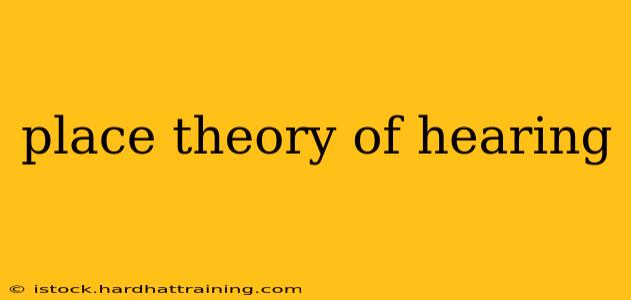The human ear is a remarkable instrument, capable of detecting a vast range of sounds, from the gentle whisper to the roar of a jet engine. Understanding how we perceive these sounds, particularly their pitch, has been a subject of intense scientific inquiry. One of the leading theories explaining pitch perception is the place theory of hearing, also known as the place code theory. This article delves into the intricacies of this theory, exploring its mechanisms, supporting evidence, and limitations.
Understanding the Basics of Pitch Perception
Before diving into the place theory, it's crucial to understand what pitch is. Pitch is the perceptual correlate of frequency—a higher frequency sound wave is perceived as a higher pitch, and vice versa. Our auditory system must somehow translate the physical properties of sound waves (frequency and amplitude) into our subjective experience of pitch and loudness. The place theory proposes a specific mechanism for this translation, focusing on the location of activation within the cochlea.
The Cochlea: The Key Player in Place Theory
The cochlea, a fluid-filled, snail-shaped structure within the inner ear, is the critical component in the place theory of hearing. This coiled structure contains the basilar membrane, a crucial structure lined with thousands of tiny hair cells, known as stereocilia. These hair cells are the sensory receptors for hearing.
The basilar membrane's key feature is its tonotopic organization. This means different frequencies of sound cause maximum vibration at different locations along the membrane. High-frequency sounds cause maximal vibration at the base (near the oval window), while low-frequency sounds cause maximal vibration at the apex (the tip of the cochlea). This spatial arrangement forms the basis of the place theory.
How Place Theory Works
According to place theory, when a sound wave enters the cochlea, it causes vibrations along the basilar membrane. The location of maximal vibration corresponds to the frequency of the sound. The hair cells at this location are stimulated, sending neural signals to the brain via the auditory nerve. The brain then interprets the location of the activation on the basilar membrane as a specific pitch. Essentially, the brain "reads" the location of maximal activation on the tonotopic map to determine the pitch of the sound.
Evidence Supporting Place Theory
Significant evidence supports the place theory of hearing:
- Tonotopic Organization: The tonotopic organization of the basilar membrane, clearly demonstrated through various experiments, is the cornerstone of this theory. Damage to specific areas of the basilar membrane results in the loss of hearing for specific frequency ranges.
- Electrophysiological Studies: Studies using electrophysiological techniques have directly recorded the activity of hair cells in response to different frequencies, confirming the location-frequency relationship.
- Imaging Techniques: Modern brain imaging techniques have further strengthened the evidence by visualizing the activity in auditory cortex areas corresponding to specific frequencies.
Limitations of Place Theory
While place theory is a cornerstone of our understanding of pitch perception, it has limitations:
- Low-Frequency Sounds: Place theory struggles to fully explain the perception of low-frequency sounds. The basilar membrane's vibrations for low frequencies are less localized, making it difficult to pinpoint the exact location of maximal displacement. Other theories, such as the temporal theory, better account for low-frequency pitch perception.
- Complex Sounds: Place theory primarily addresses pure tones. Its ability to account for the perception of complex sounds, which comprise multiple frequencies, is less clear.
Conclusion: A Comprehensive Theory, Yet Not the Entire Picture
The place theory of hearing provides a compelling explanation for our perception of pitch, especially for higher frequencies. The tonotopic organization of the basilar membrane, a critical aspect of this theory, is well-established. However, it's not a complete explanation, with limitations in explaining low-frequency sound perception and complex sound analysis. Combining place theory with other theories like the temporal theory provides a more complete picture of our intricate auditory system and its remarkable ability to perceive the nuances of sound. Further research continues to refine our understanding of this fascinating area of sensory perception.
